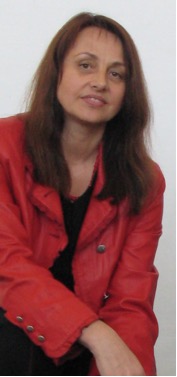


Artistic works of Dalia Marija Saulauskaite take a very important place in the context of the Lithuanian leather art. And this is not only for the reason she is one of the best and most interesting artists in this field, but also because the author is always notable for her productivity, innovation and original works. At the end of the seventies, when the author started its artistic career, compositions featuring high reliefs, massed motives mainly of plant-related or, more rarer, of abstract or thematic nature, were characteristic for the then leather art in the country. But in artistic works of several leather artists of the young generation, Saulauskaite including, pictures or forms gradually became of secondary importance and more and more emphasis was placed on the natural beauty of the material itself. Efforts were taken to highlight specific, unique peculiarities and potential of leather; there emerged artistic works based on the aesthetics of minimalism, where plane or ruffled, or kilted surface emphasised the natural plastic properties of leather - warm colours and tones, textures, elasticity and softness. A characteristic feature of Saulauskaite's works was her refusal of an utilitarian pattern of works and becoming the first author of wall pictures of leather plastics. This was her way from the applied arts to visual arts. At that time it was a brave and unexpected turn. She was creating compositions balancing between abstraction and landscape with highlighted beauty of silence, vacuum, halftones of warm colours, light and factures, suggestively memorialising emotions and inner states instead of stylised fragments or ornaments of an external world. Her compositions, sentimental and moony from the beginning, became sharper and more clamorous later on (in the nineties) - cut, slashed, scythed leather surface and bright colours were telling about distress or pain. These were the forms dictated by the material itself and moulded to the forms of the inner world of a man.
But this artist has never stayed at the same place: the tools and methods of expression change with each cycle of her works. Bright colours and unusual combinations of materials, as seen in her later works, were quite surprising (leather and glass, leather and mirrors, leather and coins), not to mention continuous technological experiments in leather finishing and, finally, her tendency to conceptualism. The author�s latest works with coins are also outstanding in the context of her oeuvre. They differ in rationality, mathematical preciseness and calculations, but simple geometric shapes, symbolic of colours, contrasts, rhythm, sequences and semantics of coins create quite a complicated and multi-level sphere of implications, while splitting of the works in several tessellation elements provides them with changing capacities, flexibility, jocosity and continuation of the process of the oeuvre. The number, size, layout of coins is not accidental and aim at revealing complicated relations between an individual and entirety, infinity of incessant moving and the stream of time. Concurrently, the coins serve as an ideal reference to here and now, to the time and place of our current lives, so these works of art also feature a national/historical aspect.
D.M.Saulauskaite is always an active participant of exhibitions held in Lithuania and foreign countries. She is often awarded positive evaluations of the critics and her works are of indubitable high importance for the development of leather art at the end of the 20th century. We are happy to have her kindly and openly sharing her experience and knowledge with representatives of the new generation at the Siauliai University. Ruta Taukinaityte-Narbutiene, 2006.